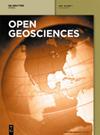Optimizing agricultural land use: A GIS-based assessment of suitability in the Sana River Basin, Bosnia and Herzegovina
IF 1.7
4区 地球科学
Q3 GEOSCIENCES, MULTIDISCIPLINARY
引用次数: 0
Abstract
The research subject is the application of geographic information systems (GIS) in assessing land suitability for agriculture in the Sana River Basin in Bosnia and Herzegovina. The aim of the research is to apply the analytic hierarchy process (AHP) in identifying suitable areas for agricultural production. Within the AHP framework, the following factors were considered: pedology, land use, elevation, slope, aridity index, and distance from rivers. The results of the suitability assessment underwent reclassification (RP) and cluster analysis processes (CAPs). It was found that very unsuitable land (1) covers an area of 0.15% (RP) or 5.83% (CAP), unsuitable land (2) covers 3.44% (RP) or 17.52% (CAP), conditionally suitable land (3) covers 32.11% or 28.47% (CAP), suitable land (4) covers 56.29% or 28.57% (CAP), and very suitable land (5) covers 7.98% (RP) or 19.59% (CAP). At the study area level, a supervised classification process was conducted to identify land use classes: meadows/pastures, water, forest, agricultural, and built-up areas. RP and CAP results were overlaid with supervised classification results to determine the amount of land used for agricultural purposes within each suitability class. It was determined that currently, for agricultural purposes, 0.04 km优化农业用地:基于地理信息系统的波斯尼亚和黑塞哥维那萨纳河流域适宜性评估
研究课题是应用地理信息系统 (GIS) 评估波斯尼亚和黑塞哥维那萨纳河流域的农业用地适宜性。研究的目的是应用层次分析法(AHP)确定适合农业生产的地区。在 AHP 框架内,考虑了以下因素:土壤学、土地利用、海拔、坡度、干旱指数和与河流的距离。适宜性评估结果经过了重新分类 (RP) 和聚类分析过程 (CAP)。结果发现,非常不适宜土地(1)的面积为 0.15%(RP)或 5.83%(CAP),不适宜土地(2)的面积为 3.44%(RP)或 17.52%(CAP),有条件适宜土地(3)的面积为 32.11%或 28.47%(CAP),适宜土地(4)的面积为 56.29%或 28.57%(CAP),非常适宜土地(5)的面积为 7.98%(RP)或 19.59%(CAP)。在研究区域层面,通过监督分类程序确定了土地利用等级:草地/牧场、水域、森林、农业和建筑区。将 RP 和 CAP 结果与监督分类结果重叠,以确定每个适宜性等级中的农业用地数量。经确定,目前用于农业目的的非常不适宜土地(1)为 0.04 平方公里(RP)或 0.88 平方公里(CAP),不适宜土地(2)为 0.41 平方公里(RP)或 7.28 平方公里(CAP),不适宜土地(3)为 15.75 平方公里(RP)或 7.28 平方公里(CAP)。75平方公里(可耕地)或 27.52 平方公里(可耕地)为条件适宜土地(3),185.15 平方公里(可耕地)或 107.06 平方公里(可耕地)为适宜土地(4),42.99 平方公里(可耕地)或 101.65 平方公里(可耕地)为非常适宜土地(5)。这些研究成果对于阐明土地利用方式作为农业重要自然资源的潜力和制约因素具有重要意义。这些研究成果对相关机构的农业部门发展和及时做出土地利用规划决策以促进可持续发展也具有重要的现实意义。
本文章由计算机程序翻译,如有差异,请以英文原文为准。
求助全文
约1分钟内获得全文
求助全文
来源期刊

Open Geosciences
GEOSCIENCES, MULTIDISCIPLINARY-
CiteScore
3.10
自引率
10.00%
发文量
63
审稿时长
15 weeks
期刊介绍:
Open Geosciences (formerly Central European Journal of Geosciences - CEJG) is an open access, peer-reviewed journal publishing original research results from all fields of Earth Sciences such as: Atmospheric Sciences, Geology, Geophysics, Geography, Oceanography and Hydrology, Glaciology, Speleology, Volcanology, Soil Science, Palaeoecology, Geotourism, Geoinformatics, Geostatistics.
 求助内容:
求助内容: 应助结果提醒方式:
应助结果提醒方式:


